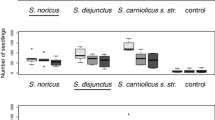Abstract
Background and aims
Serpentine soils impose limits on plant growth and survival and thus provide an ideal model for studying plant adaptation under environmental stress. Despite the increasing amount of data on serpentine ecotypic differentiation, no study has assessed the potential role of polyploidy. We tested for links between polyploidy and the response to serpentine stress in Knautia arvensis, a diploid-tetraploid, edaphically differentiated complex.
Methods
Variation in growth, biomass yield and tissue Mg and Ni accumulation in response to high Mg and Ni concentrations were experimentally tested using hydroponic cultivation of seedlings from eight populations of different ploidy and edaphic origin.
Results
Regardless of ploidy level, serpentine populations exhibited higher tolerance to both Mg and Ni stress than their non-serpentine counterparts, suggesting an adaptive character of these traits in K. arvensis. The effect of ploidy was rather weak and confined to a slightly better response of serpentine tetraploids to Mg stress and to higher biomass yields in tetraploids from both soil types.
Conclusions
The similar response of diploid and tetraploid serpentine populations to edaphic stress corresponded with their previously described genetic proximity. This suggests that serpentine tolerance might have been transmitted during the local autopolyploid origin of serpentine tetraploids.



Similar content being viewed by others
Abbreviations
- AFLP:
-
Amplified fragment length polymorphism
- Ca:
-
Calcium
- ICP OES:
-
Inductively coupled plasma optical emission spectrometry
- Mg:
-
Magnesium
- Ni:
-
Nickel
References
Antonovics J, Bradshaw AD, Turner RG (1971) Heavy metal tolerance in plants. In: Cragg JB (ed) Advances in Ecological Research. Academic Press, pp 1–85
Asemaneh T, Ghaderian SM, Baker AJM (2007) Responses to Mg/Ca balance in an Iranian serpentine endemic plant, Cleome heratensis (Capparaceae) and a related non-serpentine species, C. foliolosa. Plant Soil 293:49–59
Boyd R, Martens S (1998) Nickel hyperaccumulation by Thlaspi montanum var. montanum (Brassicaceae): a constitutive trait. Am J Bot 85:259–265
Brady KU, Kruckeberg AR, Bradshaw HD Jr (2005) Evolutionary ecology of plant adaptation to serpentine soils. Annu Rev Ecol Evol Syst 36:243–266
Chen C, Huang D, Liu J (2009) Functions and toxicity of nickel in plants: recent advances and future prospects. CLEAN – Soil, Air, Water 37:304–313
Doubková P, Suda J, Sudová R (2011) Arbuscular mycorrhizal symbiosis on serpentine soils: the effect of native fungal communities on different Knautia arvensis ecotypes. Plant Soil 345:325–338
Doubková P, Suda J, Sudová R (2012) The symbiosis with arbuscular mycorrhizal fungi contributes to plant tolerance to serpentine edaphic stress. Soil Biol Biochem 44:56–64
Ehrendorfer F (1980) Polyploidy and distribution. In: Lewis WH (ed) Polyploidy. Biological relevance. Plenum Press, New York, pp 45–60
Ehrendorfer F (1962) Beiträge zur Phylogenie der Gattung Knautia (Dipsacaceae), I. Cytologische Grundlagen und allgemeine Hinweise. Österr Bot Z 109:276–343
Gabbrielli P, Pandolfini T, Vergnano O, Palandri MR (1990) Comparison of two serpentine species with different nickel tolerance strategies. Plant Soil 122:271–277
Gabbrielli R, Pandolfini T (1984) Effect of Mg2+ and Ca2+ on the response to nickel toxicity in a serpentine endemic and nickel-accumulating species. Physiol Plant 62:540–544
Galardi F, Corrales I, Mengoni A, Pucci S, Barletti L, Barzanti R, Arnetoli M, Gabbrielli R, Gonnelli C (2007) Intra-specific differences in nickel tolerance and accumulation in the Ni-hyperaccumulator Alyssum bertolonii. Environ Exp Bot 60:377–384
Ghasemi R, Ghaderian SM (2009) Responses of two populations of an Iranian nickel-hyperaccumulating serpentine plant, Alyssum inflatum Nyar., to substrate Ca/Mg quotient and nickel. Environ Exp Bot 67:260–268
Hansen TH, Laursen KH, Persson DP, Pedas P, Husted S, Schjoerring JK (2009) Micro-scaled high-throughput digestion of plant tissue samples for multi-elemental analysis. Plant Methods 5:12
Harrison S, Rajakaruna N (2011) Serpentine: the evolution and ecology of a model system. University of California Press
Huss-Danell K (1978) Nitrogenase activity measurements in intact plants of Alnus incana. Physiol Plant 43:372–376
Jenny H (1980) The soil resource. Origin and behaviour
Kaplan Z (1998) Relict serpentine populations of Knautia arvensis s.l. (Dipsacaceae) in the Czech Republic and an adjacent area of Germany. Preslia 70:21–31
Kazakou E, Dimitrakopoulos PG, Baker AJM, Reeves RD, Troumbis AY (2008) Hypotheses, mechanisms and trade-offs of tolerance and adaptation to serpentine soils: from species to ecosystem level. Biol Rev 83:495–508
Kolář F, Fér T, Štech M, Trávníček P, Dušková E, Schönswetter P, Suda J (2012) Bringing together evolution on serpentine and polyploidy: spatiotemporal history of the diploid-tetraploid complex of Knautia arvensis (Dipsacaceae). PLoS One 7:e39988
Kolář F, Štech M, Trávníček P, Rauchová J, Urfus T, Vít P, Kubešová M, Suda J (2009) Towards resolving the Knautia arvensis agg. (Dipsacaceae) puzzle: primary and secondary contact zones and ploidy segregation at landscape and microgeographic scales. Ann Bot 103:963–974
Kruckeberg AR (1967) Ecotypic response to ultramafic soils by some plant species of northwestern United States. Brittonia 19:133–151
Levin DA (2002) The role of chromosomal change in plant evolution. Oxford University Press, Oxford
Ložek V (1973) Příroda ve čtvrtohorách (Nature in the Quaternary). Academia, Praha
Mráz P, Španiel S, Keller A, Bowmann G, Farkas A, Šingliarová B, Rohr RP, Broennimann O, Müller-Schärer H (2012) Anthropogenic disturbance as a driver of microspatial and microhabitat segregation of cytotypes of Centaurea stoebe and cytotype interactions in secondary contact zones. Ann Bot 110:615–627
Nyberg Berglund A-B, Dahlgren S, Westerbergh A (2004) Evidence for parallel evolution and site-specific selection of serpentine tolerance in Cerastium alpinum during the colonization of Scandinavia. New Phytol 161:199–209
O’ Dell RE, Claassen VP (2006) Relative performance of native and exotic grass species in response to amendment of drastically disturbed serpentine substrates. J Appl Ecol 43:898–908
O’ Dell RE, Rajakaruna N (2011) Intraspecific variation, adaptation, and evolution. In: Harrison S, Rajakaruna N (eds) Serpentine: Evolution and ecology in a model system. University of California Press, pp 97–137
Otto SP, Whitton J (2000) Polyploid incidence and evolution. Annu Rev Genet 34:401–437
Parisod C, Holderegger R, Brochmann C (2010) Evolutionary consequences of autopolyploidy. New Phytol 186:5–17
Proctor J (1971) The plant ecology of serpentine: II. Plant response to serpentine soils. J Ecol 59:397
Proctor J, McGowan ID (1976) Influence of magnesium on nickel toxicity. Nature 260:134–134
Proctor J, Woodell SRJ (1975) The ecology of serpentine soils. In: MacFadyen A (ed) Advances in ecological research. Academic Press, pp 255–366
Ramsey J (2011) Polyploidy and ecological adaptation in wild yarrow. PNAS 108:7096–7101
Ramsey J, Robertson A, Husband B (2008) Rapid adaptive divergence in New World Achillea, an autopolyploid complex of ecological races. Evolution 62:639–653
Ramsey J, Schemske DW (2002) Neopolyploidy in flowering plants. Annu Rev Ecol Syst 33:589–639
Ramsey J, Schemske DW (1998) Pathways, mechanisms, and rates of polyploid formation in flowering plants. Annu Rev Ecol Syst 467–501
Reeves RD, Bakwer AJM (1984) Studies on metal uptake by plants from serpentine and non-serpentine populations of Thlaspi goesingense Hálácsy (Cruciferae). New Phytol 98:191–204
Robertson AI (1985) The Poisoning of roots of Zea mays by nickel ions, and the protection afforded by magnesium and calcium. New Phytol 100:173–189
Soltis DE, Albert VA, Leebens-Mack J, Bell CD, Paterson AH, Zheng C, Sankoff D, dePamphilis CW, Wall PK, Soltis PS (2009) Polyploidy and angiosperm diversification. Am J Bot 96:336–348
StatSoft, Inc. (2007) STATISTICA (data analysis software system), version 8.0. www.statsoft.com
Štěpánek J (1997) Knautia L.– chrastavec. In: Slavík B (ed) Květena České republiky. Academia, Praha, pp 543–554
Štěpánek J (1989) Chrastavec rolní krkonošský—Knautia arvensis (L.) Coulter subsp. pseudolongifolia (Szabó) O. Schwarz. Vybrané ohrožené druhy flóry ČSR. Studie ČSAV 10:25–36
Vergnano O, Gabbrielli R, Pancaro L (1982) Nickel, chromium and cobalt in plants from Italian serpentine areas. Acta Oecologia, Oecologia Plantarum 3:291–306
Westerbergh A (1994) Serpentine and non-serpentine Silene dioica plants do not differ in nickel tolerance. Plant Soil 167:297–303
Acknowledgements
We thank Jan Suda and Radka Sudová for valuable comments on an earlier draft of the manuscript. Frederick Rooks kindly improved our English. The project was supported by the Grant Agency of Charles University in Prague (GAUK 418411) and the Grant Agency of the Academy of Sciences of the Czech Republic (project numbers KJB601110627 and KJB600050812). Additional support was provided by the Academy of Science of the Czech Republic (RVO 67985939) and institutional resources of the Ministry of Education, Youth and Sports of the Czech Republic for the support of science and research.
Author information
Authors and Affiliations
Corresponding author
Additional information
Responsible Editor: Fangjie Zhao.
Electronic supplementary material
Below is the link to the electronic supplementary material.
Table OR1 (Online Resource 1)
Effect of manipulated Mg and Ni concentrations, ploidy level and substrate of origin on the growth of Knautia arvensis plants in hydroponic cultivation—complete ANOVA results. (PDF 277 kb)
Table OR2 (Online Resource 2)
Effect of manipulated Mg and Ni concentrations, ploidy level and substrate of origin on biomass of Knautia arvensis plants harvested at the end of the hydroponic cultivation experiment—complete ANOVA results. (PDF 288 kb)
Fig. OR3 (Online Resource 3)
Response in total root growth (A) and longest leaf growth (B) of Knautia arvensis plants to the interaction between low (−) vs. high (+) concentrations of Mg and the absence (−) vs. presence (+) of Ni in experimental solutions. Symbols and vertical bars denote the mean and standard error of the mean, respectively. (PDF 174 kb)
Fig. OR4 (Online Resource 4)
Different response in longest root growth (A) and lateral root formation (B) of serpentine and non-serpentine Knautia plants to low (−) vs. high (+) concentrations of Mg and the absence (−) vs. presence (+) of Ni in experimental solutions. Symbols and vertical bars denote the mean and standard error of the mean, respectively. (PDF 168 kb)
Fig. OR5 (Online Resource 5)
Response in total root growth (A) longest root growth (B), lateral root formation (C) and longest leaf growth (D) of examined populations of Knautia arvensis cultivated in four different experimental solutions with manipulated concentrations of Mg and Ni (C = control, i.e., standard nutrient solution). Note the different response of the serpentine (S1–S4) vs. non-serpentine (NS1–NS4) populations to elevated concentrations of Mg and Mg + Ni. Symbols and vertical bars denote the mean and standard error of the mean, respectively. (PDF 212 kb)
Fig. OR6 (Online Resource 6)
Different yields of belowground (A) and aboveground (B) biomass of Knautia arvensis plants differing in ploidy level (diploid vs. tetraploid) and substrate of origin (serpentine vs. non-serpentine) planted in low (−) vs. high (+) concentrations of Mg. Symbols and vertical bars denote the mean and standard error of the mean, respectively. (PDF 178 kb)
Table OR7 (Online Resource 7)
Effect of manipulated Mg and Ni concentrations in experimental solution, ploidy level, and substrate of origin on the concentrations of Mg and Ni in Knautia arvensis aboveground biomass—complete ANOVA results. Differences in Ni accumulation were tested only for plants grown in Ni-enriched solutions. (PDF 287 kb)
Table OR8 (Online Resource 8)
Concentrations (mean ± s.e.m.) of Mg and Ni in the biomass of Knautia arvensis plants cultivated in different experimental solutions with manipulated concentrations of Mg and Ni and categorized according to their ploidy level (diploid vs. tetraploid) and substrate of origin (serpentine vs. non-serpentine). (PDF 166 kb)
Fig. OR9 (Online Resource 9)
Different accumulation of Mg in aboveground tissues of diploid vs. tetraploid Knautia arvensis plants in relation to the concentration of Mg in experimental solutions. Symbols and vertical bars denote the mean and standard error of the mean, respectively. (PDF 168 kb)
Fig. OR10 (Online Resource 10)
Concentration of magnesium (A) and nickel (B) in aboveground biomass of Knautia arvensis plants from investigated populations cultivated in four different experimental solutions with manipulated concentrations of Mg and Ni (C = control, i.e., standard nutrient solution). Open symbols and vertical bars denote the mean and standard error of the mean, respectively. Ni accumulation was measured only in plants grown in Ni-enriched solutions. (PDF 221 kb)
Rights and permissions
About this article
Cite this article
Kolář, F., Dortová, M., Lepš, J. et al. Serpentine ecotypic differentiation in a polyploid plant complex: shared tolerance to Mg and Ni stress among di- and tetraploid serpentine populations of Knautia arvensis (Dipsacaceae). Plant Soil 374, 435–447 (2014). https://doi.org/10.1007/s11104-013-1813-y
Received:
Accepted:
Published:
Issue Date:
DOI: https://doi.org/10.1007/s11104-013-1813-y




